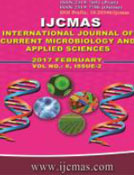


 National Academy of Agricultural Sciences (NAAS)
National Academy of Agricultural Sciences (NAAS)

|
PRINT ISSN : 2319-7692
Online ISSN : 2319-7706 Issues : 12 per year Publisher : Excellent Publishers Email : editorijcmas@gmail.com / submit@ijcmas.com Editor-in-chief: Dr.M.Prakash Index Copernicus ICV 2018: 95.39 NAAS RATING 2020: 5.38 |
Periodontitis is a chronic inflammation of the periodontium which progresses to bone resorption and tooth loss in the event of delayed or lack of treatment. Chronic periodontitis is recognized as the most frequently occurring form of periodontitis which is mainly attributed to the presence of Gram negative anaerobic organisms in the sub gingival plaque of these patients. However there are wide differences in the proportion of type of microorganisms in different geographical areas attributed to ethnicity, dietary habits and socio economic status. So the study of sub gingival microbiota in a particular country becomes relevant for understanding their implications in the pathogenesis of periodontal disease and also to identify their possible impact on treatment outcomes. As there is a paucity of information on the prevalence of Gram negative anaerobic micro organisms in our population, the present study was under taken to isolate and identify the Gram negative anaerobic bacilli. This cross sectional study was carried out between January and December 2013 on 71 chronic periodontitis and 55 healthy subjects attending the dental outpatient department of our tertiary care hospital. The sub gingival plaque samples were processed using anaerobic culture to isolate obligate anaerobic Gram negative bacilli. Identification was performed using special potency antimicrobial discs and standard biochemical reactions. 71.84% in chronic periodontitis and 50.91% in healthy participants showed the presence of obligate anaerobic Gram negative bacilli. Porphyromonas (13.18%), Prevotella (32.97%), Bacteroides (24.17%) and Fusobacterium (29.67%) were isolated in chronic periodontitis while Porphyromonas (8.69%), Prevotella (30.43%), Bacteroides (26.08%) and Fusobacterium (34.78%) were isolated from the control group. The proportion of these putative pathogens was found to be higher in chronic periodontitis patients when compared to healthy subjects. The presence of anaerobic Gram negative bacilli in both study groups points towards the possibility of an opportunistic role that these organisms assume in the presence of risk factors.
 |
 |
 |
 |
 |